
S c o t l a n d
d a y 9
Travel Home
Travelogue
Planning
Resources
Itinerary
Scottish Castles
Abbeys and Kirks
Other sights
email Phouka
s u n d a y m a y 2 3 1 9 9 9
Breakfast once again proved the inability of anyone to make toast, but otherwise was good. I still can't get used to the cooked tomato, though. Mark orders scrambled eggs on toast (which is to become a habit) and I eat the bacon.
Meals (well, the non-breakfast ones) always come with "veg", too. A bowl of potatoes, broccoli, carrots, rutabagas or turnips. Marks says that rutabagas are just carrots that got too much water and too little sun. The perfect Scottish vegetable!
We checked out and set off to wander around Stirling. Old town Stirling is charming -- cobbled sidewalks and row upon row of old houses and churches. It's a very inviting and friendly town. We just took off towards the castle, up a road called, appropriately enough, Castle Wynd. We wandered past the Erskine Monument, and the impressive Erskine Marykirk that has the historic Stirling cemetery. Clambering up to the viewpoint of Lady's Rock, where the women would congregate to watch tournaments in the valley below, you can get a beautiful view of Stirling Castle. There is also a pyramid in the cemetery that is dedicated to religious martyrs. It's a strange sight sitting among the ancient stones. The earliest graves had no dates on the stone markers, just skulls and hourglasses and maybe a guild mark. A plaque says that at least two date from the 1530s. The Boy's Club was a hoot, too.
Across the Castle Wynd from the cemetery is a 15th century townhouse called Argyll's Lodging (or Ludging). It's a neat tour of furnished rooms in a grand town house. I was especially impressed with the 'trunk potties' with padded purple seats. National Trust did a wonderful job on the restoration work. It's interesting to see where the different centuries were added on to the house.
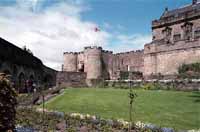 We got a late start today, didn't have breakfast until 10 or check out until 11am. It's kind of nice to have a leisurely day. We've finally figured out how to vacation together. I'm a bit less inflexible, and Mark is a bit less 'go-go-go'. We got pretty stressed out about it, but we're better now.
We got a late start today, didn't have breakfast until 10 or check out until 11am. It's kind of nice to have a leisurely day. We've finally figured out how to vacation together. I'm a bit less inflexible, and Mark is a bit less 'go-go-go'. We got pretty stressed out about it, but we're better now.
We went back to the car for film, and decided to drive up to Stirling Castle. We didn't realize they'd charge us to park. BTW, we're not using enough film.
Stirling Castle is pretty cool -- very large and still in active use. Quite different from most of the ruins that we've been visiting. It's a bit "commercial" -- audio tours and guided groups and tons of people -- but Mark is fascinated by the battleworks and cannons. He still is most impressed by the military fortification standpoint of the castles we visit. As I said, Stirling is huge, with lovely gardens. It's hard to get the size, or the impression of enormity, from the pictures, but it is truly imposing.
Inside the walls, HS has begun the final stages of a 35 YEAR restoration project of the Great Hall. It's really quite a shock, really. The Great Hall has been reroofed, reharled, and is a smooth pinkish-salmon color. It's a huge difference from the dark brown-gray of the other stone buildings. However, it's historically accurate, even if it's odd.
There's a neat display inside of the restoration process, but we cannot go inside the Great Hall yet. The "hammer beam roof" is complete, though, requiring 400 oak trees and a careful jigsaw puzzle layout plan for each piece to fit.
Stonemasons are repairing the walls when they can, replacing when they must, almost 30K tons of new stone fitted carefully into the gaps. It's amazing, and as historically accurate as they can make it -- down to the color, the windows, and most of the decorations, taken from descriptions in books and letters and other research.
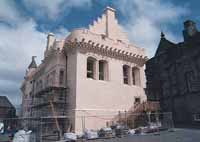 It's going to be stunning when it's finished, which should be this year, in time for the millennium celebration. THey just took the protective tarps off a month ago. It almost looks cartoonish, like a play castle stuck in the middle of the courtyard. I wonder what the whole castle looked like, it was completely done. Maybe it's the smoothness that's so jarring, compared to the rough stone of the rest of the walls.
It's going to be stunning when it's finished, which should be this year, in time for the millennium celebration. THey just took the protective tarps off a month ago. It almost looks cartoonish, like a play castle stuck in the middle of the courtyard. I wonder what the whole castle looked like, it was completely done. Maybe it's the smoothness that's so jarring, compared to the rough stone of the rest of the walls.
We didn't know why the walls looked so pockmarked -- some smooth stone, some edges around doors and windows have been obviously replaced, while some wall faces, even though also obviously replaced, were still rough. Maybe it was refacing vs. replacing? Did they only replace the structural problems?
We spent a good hour and a half in the Argyll and Sutherland Highland Regimental Museum. This highland regiment was the origin of the phrase "Thin Red Line", and has received 172 battle honors -- for comparison, the most decorated unit of the US Army, the 2/7 Infantry, has 76. Mark was very impressed, and said that the 2/7 had actually fought the regiment once in Louisiana. He can't think of a war that the British fought in that the Highland regiment did not play a part. Pretty stirring stuff.
Very touching, too. They did a good job with the collected artifacts and personal items from the soldiers. The display of the crumbling colors from the Crimean War were quite moving. The Argyll's are 'Princess Louise's" Highlanders, Each year, Queen Elizabeth comes down to take a photo with the Royal Guard. Lots of young men in kilts.
From Stirling Castle you can see the tall folly built in a nearby cliff -- the Wallace Monument. It's a skinny tower with audio/visual displays, statues, reenactments, etc. It has 246 stairs in a tiny circular staircase along one side that go to the top where there is a lookout/ledge over Stirling.
Let me point out once again that the wind is FIERCE. It has to be gusting to 70mph, and we're going to climb this humungous hill and then climb the space needle. Crazy.
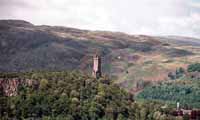 The walk up is VERY steep, but paved and with benches. It takes about 10 minutes to climb up, more if you collapse on the benched periodically to wave at the people heading down. We sat down on one of the benches about 2/3 of the way up to catch our (my!) breath, and decided to take the shortcut stairs up to the tower. Shorter, but more vertical. I should have thought of that!
The walk up is VERY steep, but paved and with benches. It takes about 10 minutes to climb up, more if you collapse on the benched periodically to wave at the people heading down. We sat down on one of the benches about 2/3 of the way up to catch our (my!) breath, and decided to take the shortcut stairs up to the tower. Shorter, but more vertical. I should have thought of that!
The wind is physically shocking on the base platform -- it buffets you around pretty hard. Luckily there are high railings. Finally getting inside the tower was blissfully quiet.
Then, the Wallace Death March begins. Up 246 tiny, triangular, winding stairs. And up. And up. I made it the whole way -- stopping along with everyone else to see the displays on each of the four floors. According to one display, the supposed 'real' sword of William Wallace, he was between 6'6" and 6'7" tall, just in order to wield the sword. I think that may have been a ceremonial sword, not meant to be used in battle, and therefore a bit larger than life, but this is not the first time we've heard the "giant" estimates.
The top, reached panting and sweating and quite ready to whine, has a truly amazing view over Stirling and the surrounding countryside. It was gusty up there, and I stayed very close to the center of the platform, although Mark ventured a bit forward. Not that there was really any chance that we'd blow off, but it was scary.
Down the stairs was actually harder -- I pulled something in my knee that hurts something awful when I go down. Up is fine. Down is quite hard. The road up is steep enough that you have to go down kind of leaning backwards. It's hard to do, and squishes your toes up in the ends of your shoes. On the way down, I was commenting that I was glad this wasn't Boulder, where we'd find joggers -- and lo and behold, a RUNNER is heading up the hill. "Ok, I'll tackle him and you bludgeon him with a rock." This guy was moving pretty fast, too. He had to have been a Marine, or one of the garrison from the castle. Only a stupid Lieutenant would try that! Not two minutes later he was barreling down the hill at a barely controlled pace.
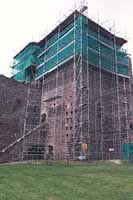 Doune Castle, our next stop, was under repair as well. It must be the season. They're repointing the outer walls and repairing the wall walk. Doune is mostly complete and there are few changes to the original structure. Best known as the filming location for 'Monty Python and the Holy Grail', Doune is quite stark. The walls are straight, flat, tall. On the far wall, the windows are at different levels...someone changed their mind halfway through construction. Since we always warn people that changes made late in the process are more expensive, I can't imagine changing a plan designed for stone!
Doune Castle, our next stop, was under repair as well. It must be the season. They're repointing the outer walls and repairing the wall walk. Doune is mostly complete and there are few changes to the original structure. Best known as the filming location for 'Monty Python and the Holy Grail', Doune is quite stark. The walls are straight, flat, tall. On the far wall, the windows are at different levels...someone changed their mind halfway through construction. Since we always warn people that changes made late in the process are more expensive, I can't imagine changing a plan designed for stone!
We walk out along the NE corner of the castle and up the hill that is presumed to be a roman hill fort. It was the original castle on the site, at the convergence of two rivers, and therefore very important to control trade, and the new (current) castle is nearby.
Our B&B for the night is in Bo'ness, near Edinburgh (again!). We called from the hotel this morning, really planning ahead! So we headed in. We stopped at Blackness Castle, which is a terribly grim fortress in the harbor, gray and stark and very foreboding. It was mostly used as a prison, and in modern times an ammo depot, and really looks the part. But, since it was so recently used, it is in fabulous condition, with new wooden floors and windows. It actually has a working drawbridge to control access from the long pier. The pier is modern, built by the military so they could load ammo onto ships easily. It was windy out on the end, and the view of the Forth Bridge is hazy.
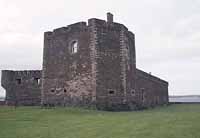 Blackness also has a particularly grim pit dungeon, or bottle dungeon -- a hole with a hatch in the middle of the roof into which you dropped your prisoners. Whereas most pit prisons are dark, airless, cold holes in the ground anyway, there is an added feature here -- at Blackness, the tides rise and ebb through a grate and drain hole. While it flushes the middens, it also fills the pit prison with a few inches of freezing water. It would have been very cold and wet, with no place to climb to escape the frigid seawater.
Blackness also has a particularly grim pit dungeon, or bottle dungeon -- a hole with a hatch in the middle of the roof into which you dropped your prisoners. Whereas most pit prisons are dark, airless, cold holes in the ground anyway, there is an added feature here -- at Blackness, the tides rise and ebb through a grate and drain hole. While it flushes the middens, it also fills the pit prison with a few inches of freezing water. It would have been very cold and wet, with no place to climb to escape the frigid seawater.
Most castles have a prison and a pit prison. The prison is not necessarily uncomfortable, often with a fireplace, window and private privy. Remember, prison is not really meant to be a punishment, it is simply where you hold people while they wait for their true punishment is meted out. Considering that punishment could be drawing and quartering or other gruesome ends -- prison was pretty comfortable. Nobles were normally confined to quarters in the castle in one or two large suites of rooms that were simply bolted from the outside.
Our B&B is a huge old house -- part (which we were in) dating from the 1600s. Newer parts of the house are still centuries old, and a part of the original house is from the 16th century, if the window lintels are to be believed. It is a listed manor house, Carriden House, based on a 15c tower house. The current owners have been there about two years and seem to be working to get things fixed and restored. The hotel wing is a bit shabby still, but it's the tolerable neglect of 'waiting to do it right' instead of lack of care. Stuff needs to be painted and furniture is mostly second hand finds but it's a charming place. We got the family room, since it is the only room with a double bed. The room was enormous -- the ceilings are 12' tall at least and the rooms was 20' on a side. It felt weird to sleep there, sine the room actually echoed. But the bed was comfy. Dinner isn't available, so we went out along the road to the Chamany Inn for burgers. The Inn has two restaurants, we ate in the pub side and had delicious burgers and fries and a bottle of wine from South Africa. It was exactly what I'd been craving. Mark, too.
©1999-2001 R. Fingerson